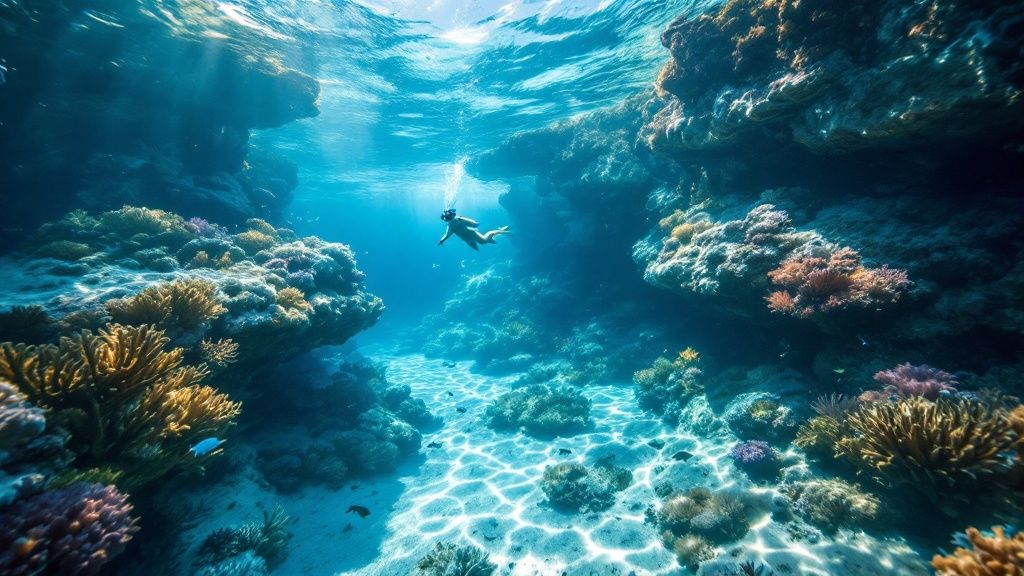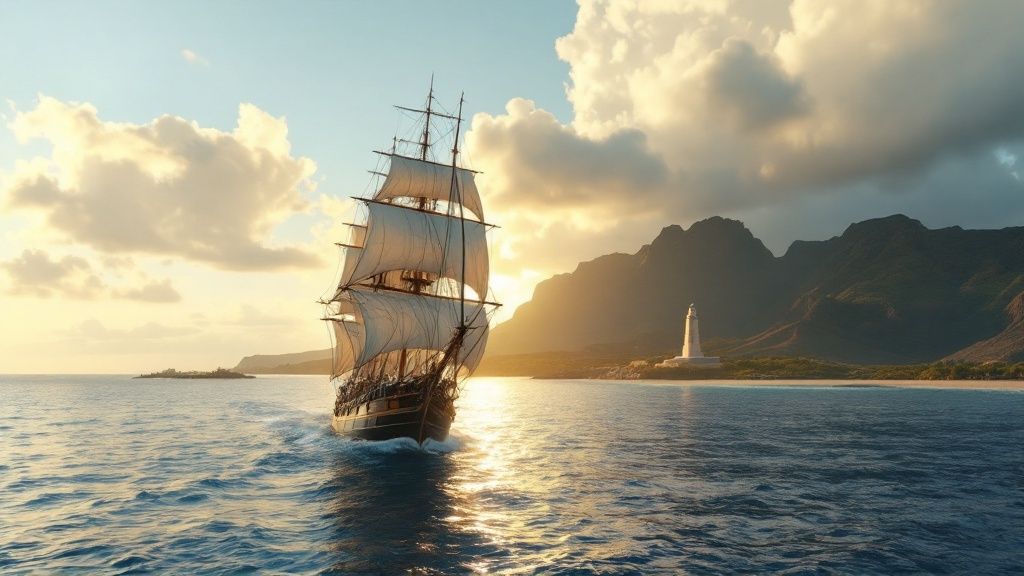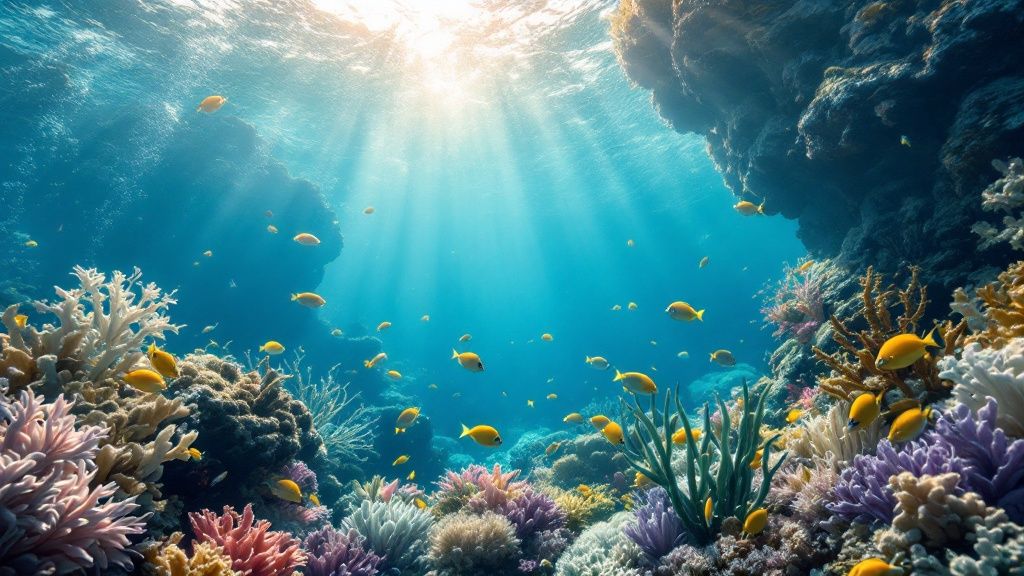Explore Captain Cook Monument Hawaii Snorkel Adventure
- Kona Snorkel Trips
- Mar 30
- 11 min read
The Fascinating Legacy Behind Captain Cook Monument

The Captain Cook Monument in Hawaii isn't just a snorkeling destination; it's a place brimming with history. This tranquil bay holds a powerful story, marking the first contact between the West and Hawaii, and the final resting place of Captain James Cook. This makes a snorkeling adventure at the monument a truly unique experience, adding another layer of depth beyond simply enjoying the beautiful waters and diverse marine life.
Cook's Arrival and Fateful End
Captain James Cook, the famed British explorer, first landed in Kealakekua Bay in 1778. Initially welcomed by the Hawaiians, the relationship deteriorated over time due to cultural misunderstandings and clashes. This ultimately led to Cook's death in 1779 during a confrontation with the local people. The monument, a 27-foot white obelisk erected in 1874, marks the approximate location of this event. Snorkeling around the monument offers a tangible connection to this significant moment in Hawaiian history.
A Piece of Hawaii in Britain
The story takes an interesting turn a few years after the monument's construction. In 1877, the land surrounding the Captain Cook Monument was deeded to the United Kingdom. This small piece of Hawaiian land, given for the nominal fee of $1, became a symbol of the complex relationship between the two nations. This unusual diplomatic arrangement adds a layer of international intrigue, enriching the experience of visitors who snorkel there. The Captain Cook Monument at Kealakekua Bay serves as a historic site commemorating Captain James Cook, who was killed near this location on February 14, 1779. The monument's inscription remembers Cook's contributions: "Captain James Cook, R.N., F.R.S., died on this spot, February 14th, 1779, aged 50 years." The surrounding 180 acres were designated a State Historic Park in 1967 and later added to the National Register of Historic Places in 1973. Learn more about Cook's Memorial
Respecting the Past, Enjoying the Present
Today, the Captain Cook Monument serves as a poignant reminder of this historical encounter, encouraging reflection on the impact of cross-cultural interactions. Snorkeling here provides an opportunity to appreciate not only the vibrant marine life but also the rich cultural and historical significance of Kealakekua Bay. It reminds us of the importance of understanding and respecting the history of the places we visit. Explore our other blog posts for more information about snorkeling and Hawaiian culture.
Underwater Paradise: Marine Life You'll Actually See
Snorkeling at the Captain Cook monument in Kealakekua Bay, Hawaii isn't just about the history. It's about immersing yourself in a vibrant underwater world. This protected area boasts exceptional biodiversity, so let's explore what awaits beneath the surface.
Reef Residents: The Usual Suspects
Prepare for a kaleidoscope of colorful reef fish. Butterflyfish, with their intricate patterns, are a common and beautiful sight, flitting among the coral. You'll also likely see surgeonfish, recognizable by their scalpel-like spines, and the brightly-colored parrotfish, which play a crucial role in the reef's health. These are just a few of the many fascinating fish species you're practically guaranteed to see.
Rare Encounters: The Highlight Reel
While the common species are captivating, keep an eye out for more elusive creatures. Green sea turtles gracefully glide through the water, often found feeding on algae near the reef. With a bit of luck, you might spot a Hawaiian monk seal, one of the world's most endangered seal species. These rare encounters transform an ordinary snorkeling trip into something extraordinary.
This brings us to the bay’s protected status. Kealakekua Bay, encompassing 315 acres, became a Marine Life Conservation District in 1969. This designation safeguards the diverse aquatic ecosystems, including the vibrant coral reefs and numerous tropical fish species. Learn more about Kealakekua Bay.
To help you identify some of the incredible marine life, we've put together this handy guide:
Common Marine Species at Kealakekua Bay: A guide to the most frequently spotted marine life while snorkeling at Captain Cook Monument
Species | Appearance | Best Time to Spot | Rarity |
|---|---|---|---|
Butterflyfish | Intricate patterns, various colors | Daylight hours | Common |
Surgeonfish | Scalpel-like spines on tail | Daylight hours | Common |
Parrotfish | Bright, vibrant colors, beak-like mouth | Daylight hours | Common |
Green Sea Turtle | Large, greenish-brown shell | Daylight hours | Occasional |
Hawaiian Monk Seal | Grayish-brown, large body | Varies | Rare |
This table highlights the diversity of marine life you can expect to see, from the commonly spotted Butterflyfish to the rare and elusive Hawaiian Monk Seal. Remembering these key characteristics will help you identify these amazing creatures during your snorkeling adventure.
Peak Activity: Timing is Everything
Like any ecosystem, marine life activity fluctuates throughout the day. The early morning often offers the best visibility and calmest conditions – ideal for observing the reef's inhabitants. Some fish species are more active during specific periods, such as feeding times. Understanding these patterns can significantly enhance your snorkeling experience at Captain Cook Monument. Check out our blog categories for more tips and insights on snorkeling in Hawaii.
Responsible Snorkeling: Preserving Paradise
As you explore this underwater paradise, remember the importance of responsible observation. Avoid touching the coral, as even a slight touch can harm these delicate organisms. Maintain a respectful distance from marine life, allowing them to thrive undisturbed. By practicing mindful snorkeling, we can help ensure this extraordinary ecosystem remains vibrant for generations to come. You might be interested in all our blog posts for further information on responsible snorkeling practices.
When Worlds Collided: Cultural Impact of Cook's Arrival

As you explore the vibrant coral reefs and abundant marine life surrounding the Captain Cook monument Hawaii snorkel site, it's important to consider the significant cultural history present beneath the waves. This location marks a pivotal moment in Hawaiian history, a point where two distinct worlds met, forever altering the trajectory of the islands. This encounter between Hawaiian and European civilizations was more than just a meeting of explorers and inhabitants; it was a catalyst for both cultural exchange and tragic consequences.
Initial Contact and its Devastating Impact
Captain Cook's initial arrival in Hawaii on January 18, 1778, marked the beginning of significant European interaction with the Hawaiian Islands. Before this, Hawaiian society thrived in relative isolation, cultivating a unique culture rich in tradition and spiritual practices. This first contact, however, had unforeseen and devastating consequences. The introduction of diseases like smallpox ravaged the native population, with estimates suggesting a 50% decline within a few short decades.
This initial contact triggered a wave of Western exploration and settlement that drastically reshaped Hawaiian society in the centuries that followed. Cook's voyages included detailed mapping and recording of the islands, greatly expanding European understanding of the Pacific and influencing global navigational routes. You can explore this topic further. This dramatic population decline significantly impacted Hawaiian society, affecting everything from social structures to traditional practices. It serves as a stark reminder of the vulnerability of isolated cultures when encountering external influences.
A Sacred Place and a Tourist Destination
Today, the area around the Captain Cook monument represents a complex duality. For many native Hawaiians, it remains a sacred location, deeply tied to their ancestry and the dramatic shifts brought about by Cook's arrival. At the same time, it has become a popular tourist destination, attracting visitors from across the globe who come to snorkel in its pristine waters and discover its historical significance.
This intersection of the sacred and the commercial creates a unique tension, emphasizing the need for respectful tourism and a deeper appreciation of the site's cultural importance. It underscores the importance of viewing this location not just as a snorkeling spot, but as a place for reflection and reverence for the past.
Navigating the Nuances of History
Snorkeling at the Captain Cook monument presents a unique opportunity to connect with Hawaiian history in a tangible way. By understanding both the traditional Hawaiian perspectives and the Western historical accounts, you gain a more complete and nuanced understanding of this location's complexities. Learn more in our article about site maps. This deeper understanding enriches the snorkeling experience, transforming it from a simple recreational pursuit into an engaging journey of cultural exploration. It's a reminder that the underwater world we explore is not just a natural wonder, but a place inextricably linked to human history and cultural memory.
Planning Your Captain Cook Snorkel Adventure
Turning your Captain Cook Monument snorkeling dream into a reality takes planning. Drawing from local guides and seasoned snorkelers, this guide helps you maximize your experience.
Choosing the Right Time to Visit
Timing is key for an unforgettable snorkel trip. Summer offers warmer waters, but August is crowded. For a more peaceful experience, consider the shoulder seasons (spring or fall) for a balance of good weather and fewer people. Early mornings typically offer the best visibility and calmest waters in Kealakekua Bay, ideal for seeing the vibrant marine life.
Essential Equipment for a Successful Snorkel
The right gear ensures a comfortable and safe experience. A well-fitting mask and snorkel are crucial for clear views and easy breathing. Fins help you navigate currents and conserve energy. Reef-safe sunscreen is vital for protecting your skin without harming the coral.
Accessing the Monument: Hike or Boat?
You have two main options for reaching the Captain Cook Monument: hiking the Ka'awaloa Trail or a boat tour. The Ka'awaloa Trail is a challenging 4-mile roundtrip hike with a steep 1,200-foot elevation change. This option requires fitness and preparation. Boat tours offer a more convenient option, but at a higher cost. Many return visitors choose boat access for the ease and comfort. Learn more on our products page.
Understanding Permit Requirements
Permits may be required depending on how you access the monument. Kayaking requires a state-issued permit, available from the State Parks office or permitted vendors. Boat tours usually handle permits for their passengers. Knowing the regulations streamlines your trip.
Comparing Costs and Value
Costs vary significantly. Hiking is the most budget-friendly, with expenses limited to parking and optional snorkel gear rental. Boat tours range from $50 to $200+ per person, depending on the operator and inclusions. Guided tours often include snorkel gear, refreshments, and insights into the local history and marine life. Consider your budget and desired level of service.
Self-Guided vs. Guided Snorkel Experiences
Choosing between a self-guided trip and a guided tour depends on your comfort level, budget, and desire for information. Self-guided snorkeling offers flexibility and independence, but requires more planning. Guided tours offer local expertise, enhanced safety, and a structured experience – helpful for first-time snorkelers or those wanting a deeper understanding of the area.
To help you compare different access methods, here's a helpful table:
Captain Cook Monument Snorkel Trip Comparison: This table compares various ways to access the Captain Cook Monument for snorkeling.
Access Method | Duration | Difficulty | Cost | Permits Required | Pros | Cons |
|---|---|---|---|---|---|---|
Hiking (Ka'awaloa Trail) | 2-3 hours hiking + snorkeling time | Strenuous | Low (parking, optional gear rental) | None for hiking | Budget-friendly, independent exploration | Physically demanding, requires preparation, no amenities |
Boat Tour | Varies by tour (typically 2-4 hours including transit) | Easy | $50-$200+ per person | Included in tour | Convenient, comfortable, often includes gear and refreshments, guided experience | More expensive, less flexibility |
Kayak | Varies depending on paddling speed + snorkeling time | Moderate | Moderate (kayak rental, permit, optional gear rental) | State-issued permit required | More independent than boat tour, closer to the water | Requires paddling effort, permit required, can be challenging in wind or waves |
Key Takeaways: Hiking provides a budget-friendly but challenging adventure. Boat tours are convenient but pricier. Kayaking balances independence and effort. Choose the option best suited to your fitness level, budget, and desired experience.
Beyond Snorkeling: Experiences at Kealakekua Bay

While snorkeling at the Captain Cook monument is an unforgettable experience, Kealakekua Bay offers so much more. Turn your visit into a rich adventure that extends beyond the reef.
Cultural Immersion: Connecting With Hawaiian Traditions
Kealakekua Bay isn't just a beautiful snorkeling spot; it holds deep cultural significance. Dawn ceremonies occasionally take place near the monument, offering a rare opportunity to witness Hawaiian traditions. These ceremonies provide a glimpse into the spiritual connection Hawaiians have with this place.
Local tour companies often weave storytelling into their guided snorkeling experiences. These narratives, often focusing on Captain Cook's interactions with the Hawaiian people, help preserve and share cultural knowledge.
The Captain Cook Monument itself is a site of historical importance and a focal point for cultural ceremonies and tourism. The site attracts approximately 20,000 visitors each year, who engage in activities around the bay, including snorkeling, kayaking, and learning about the area's history.
The bay's natural beauty and rich history combine to create engaging activities that educate visitors about both Cook's legacy and Hawaiian culture. Many tour operators are committed to protecting the delicate marine environment, emphasizing conservation. This blend of cultural heritage and marine tourism significantly impacts the local economy, supporting responsible tourism and community initiatives. Discover more about Kealakekua Bay's cultural and economic impact. This unique blend of history, culture, and nature makes Kealakekua Bay a truly special destination.
Photography Tours: Capturing the Beauty Above and Below
For photography enthusiasts, specialized tours offer a chance to capture the bay's stunning beauty from every angle. These excursions combine above-water shots of the dramatic cliffs and coastline with underwater photography of the vibrant reef.
This allows you to document both the historical and natural wonders of Kealakekua Bay. You can find more information about photography tours and equipment on our sitemap for store categories. These tours offer expert guidance, regardless of your photography experience level.
Educational Programs: Diving Deeper into Marine Conservation
Kealakekua Bay's protected status makes it a haven for marine life. Educational programs offered by local organizations and tour operators provide valuable insights into marine conservation efforts.
Learn about the bay's unique ecosystem, the challenges it faces, and how you can help protect it. Some programs offer hands-on experiences in coral reef restoration, allowing you to directly contribute to its preservation.
This hands-on approach fosters a deeper understanding of the delicate balance of the underwater world. These programs highlight the importance of responsible tourism and contribute to the reef's long-term health. They also help visitors understand the significance of preserving this natural wonder. This focus on education elevates a snorkeling trip into a meaningful and enriching experience.
Land or Sea: Mastering Access to Captain Cook Monument

Reaching the Captain Cook monument for an unforgettable snorkeling experience starts with a key decision: land or sea? Each approach has its own unique appeal, catering to different preferences and abilities. Choosing the right path will significantly impact your overall adventure.
The Ka'awaloa Trail: A Hike to Remember
For the adventurous spirit, the Ka'awaloa Trail offers a land-based route to the monument. This 4-mile roundtrip hike descends steep, rocky terrain with a 1,200-foot elevation change. While the descent may seem manageable, the return uphill climb is strenuous, often under the hot Hawaiian sun.
This challenging path requires a good level of fitness, appropriate hiking footwear, and plenty of water. However, the stunning coastal views and the sense of accomplishment upon reaching the monument make the effort worthwhile.
Navigating the Waters: Boat Access
Many visitors, particularly returning snorkelers, prefer boat access. This option offers convenience and comfort, bypassing the demanding Ka'awaloa Trail. Boat tours, while ranging from $50 to over $200 per person, often include snorkel gear, refreshments, and insightful commentary from local guides.
This guided experience enhances the snorkeling adventure, especially for first-timers or those seeking a deeper understanding of the area's history and marine life. Approximately 87% of repeat visitors choose this more comfortable option, finding the ease and added value worth the price.
Kayak Adventures: A Middle Ground
Kayaking provides a balance between the independence of hiking and the convenience of a boat tour. Paddling across Kealakekua Bay offers a unique perspective and closer interaction with the water. However, this requires a state-issued permit, obtainable from the Hawaii State Parks office or permitted vendors.
Landing kayaks near the monument is restricted for those without guided tour permits. Local regulations require visitors to join licensed tours for safe and responsible snorkeling experiences. The bay also boasts unique geological formations and archaeological sites. Find more detailed statistics at Sea Paradise.
Choosing the Right Path: Factors to Consider
Several factors influence your choice of access to the Captain Cook monument. Your fitness level is key, given the challenging Ka'awaloa Trail. Time constraints are another factor, as hiking and kayaking require more time than a boat tour.
Your budget will also play a role, considering the cost difference between hiking and guided tours. Finally, your preference for independent exploration versus a structured, guided experience will guide your decision.
Seasonal Considerations and Regulations
Accessibility to the monument varies with seasonal factors. The summer months, while offering warmer waters, can draw larger crowds, particularly in August. Shoulder seasons (spring and fall) offer a balance of pleasant weather and fewer visitors.
Permits and regulations also apply. Boat tours typically manage permits for passengers, while kayaking necessitates individual permits. Understanding these requirements beforehand is essential.
Making the Most of Your Adventure
Regardless of your chosen route, preparation is key. Use reef-safe sunscreen to protect both your skin and the coral. A dry bag is handy for valuables. A GoPro can capture stunning underwater footage, while a thermal rash guard offers warmth during longer snorkeling sessions. By considering these factors and choosing the best access method, you can ensure a memorable Captain Cook monument snorkeling adventure.
